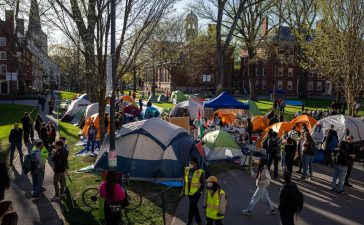
Gov. Kathy Hochul delivered the 2024 State of the State Address in the state Assembly Chambers on Jan. 9.
(Photo courtesy Office of Gov. Kathy Hochul)
Gov. Kathy Hochul has unveiled her $233 billion executive budget proposal for New York’s 2024-25 fiscal year.
Hochul said in the Red Room at the state Capitol Tuesday that despite a $6 billion, or 4.5%, spending increase, her budget proposal would not raise income taxes.
The state is projecting a $4.3 billion budget gap in the coming fiscal year. The state’s Medicaid spending alone will exceed its projections by $1.5 billion, meaning that the state will need to pay a total of $3 billion in Medicaid costs this year. Hochul said that after the federal government ended its pandemic supplemental support, the state was left to find money to maintain coverage at a cost of an additional $400 million annually.
In her executive budget, Hochul outlined the numbers behind her wishlist for the upcoming fiscal year, which she broadly outlined in her State of the State address last week. Her priorities include packages that aim to address a wide swath of issues, including crime prevention, the elimination of barriers to treatment for mental illness, addressing the youth mental health crisis and deficiencies in the broader health care system. She also hopes to invest in improving reading proficiency, swimming ability and consumer protections. She hopes to improve the state’s climate resiliency and to “harness the power” of artificial intelligence through a $275 million, 10-year investment plan into an AI consortium. Hochul proposed creating a new state Office of Civil Service to connect people with volunteer opportunities, proposed efforts aimed at curbing the prevalence of harmful algal blooms, hold steady funding for PFAS monitoring from “legacy industrial sites” and expand funding for municipalities contending with PFAS contaminants. She’s also pushing for more funding to increase water infrastructure grants for small, rural communities from 25% to 50% of net eligible project costs. The budget proposal includes $100 million for the Downtown Revitalization Initiative program.
Hochul’s budget also includes $82.5 million in new capital investments for the Lake Placid-based Olympic Regional Development Authority, which, if approved by the state Legislature, would be $2.5 million more state funding than ORDA budgeted for. Her proposal also includes $400 million for the Environmental Protection Fund, no change from 2023-24, as well as $435 million for flood resiliency projects, $500 million for clean water projects, $100 million for superfund cleanup, $47 million to plant 25 million trees by 2033 and $250 million for a “voluntary buyout program” for owners of property in flood-prone areas. The state Department of Environmental Conservation would receive $95 million to “ensure the safety and durability of our state’s dams, rehabilitate campgrounds, and upgrade a variety of widely used recreational facilities,” as well as providing “critical repairs to other public property, including wetlands, trails, waterfronts and fish hatcheries,” Hochul’s budget book reads.
Hochul again emphasized the need for the state to address the housing crisis — she said that this issue must remain at the forefront. This echoes her State of the State address last year, when she proposed a housing plan that ultimately failed after it faced backlash over city suburb provisions and local zoning overrides.
At least 10,000 people in New York City are living in homeless shelters despite having housing vouchers because there are no apartments available, Hochul said. She’s proposing new tax incentives for development, incentives for converting office buildings into housing, eliminating restrictions on residential density restrictions and creating a pathway to legalizing basement apartments.
“The answer, my friends, is not blowing in the wind — it’s shovels in the ground,” Hochul said, referencing the 1963 Bob Dylan song “Blowin’ in the Wind.”
Hochul proposed the state invest $500 million to build 15,000 units on state-owned land — Hochul’s office said state agencies have identified former correctional facilities, areas near commuter rail stations and SUNY properties which could accommodate up to 15,000 new units of housing across the state — and earmark another $25 billion to build 100,000 homes.
Unlike her State of the State address, where Hochul made no mention of the migrant crisis pushing the city of New York’s shelters and resources beyond its limits, Hochul made a point on Tuesday to underscore the financial impact this crisis will continue to have on the state’s finances if the federal government does not address the unprecedented influx of arrivals at the southern border.
“New York continues to carry the burden of housing 79,000 migrants,” Hochul said. “This is ultimately the responsibility of the federal government to address this crisis.”
Hochul said that she planned to travel to Washington, D.C. this week to encourage federal lawmakers to address the migrant crisis. But she sees this continuing to impact New York state, and that’s reflected in her executive budget.
She noted that in this past fiscal year’s budget, the state earmarked $1.5 billion to aid New York City with this crisis, a cost which ultimately increased to $1.9 billion. Her executive budget includes $2.4 billion — which will require taking $500 million from the state’s reserves — to help the city manage the crisis.
“We have no choice but to plan for those costs again in this year’s budget,” she said.
Hochul said that this was the right thing to do and necessary for the economy, because businesses will not want to operate in New York “if there’s thousands of people sleeping on the streets.” She added that she wants to ensure that migrants and asylum seekers can find work.
“That’s exactly what they came here for. That’ll continue to be our focus,” she said.
“Where do we put people? It’s not like we’ve got a lot of housing available,” she added.
For schools, Hochul is proposing $35 billion in school aid, up by 33% compared to 2021.
Her executive budget is only a proposal; the state Legislature still needs to review and approve a state budget. The budget deadline is April 1.
——
This is a breaking news story. More details will be added as they become available.






